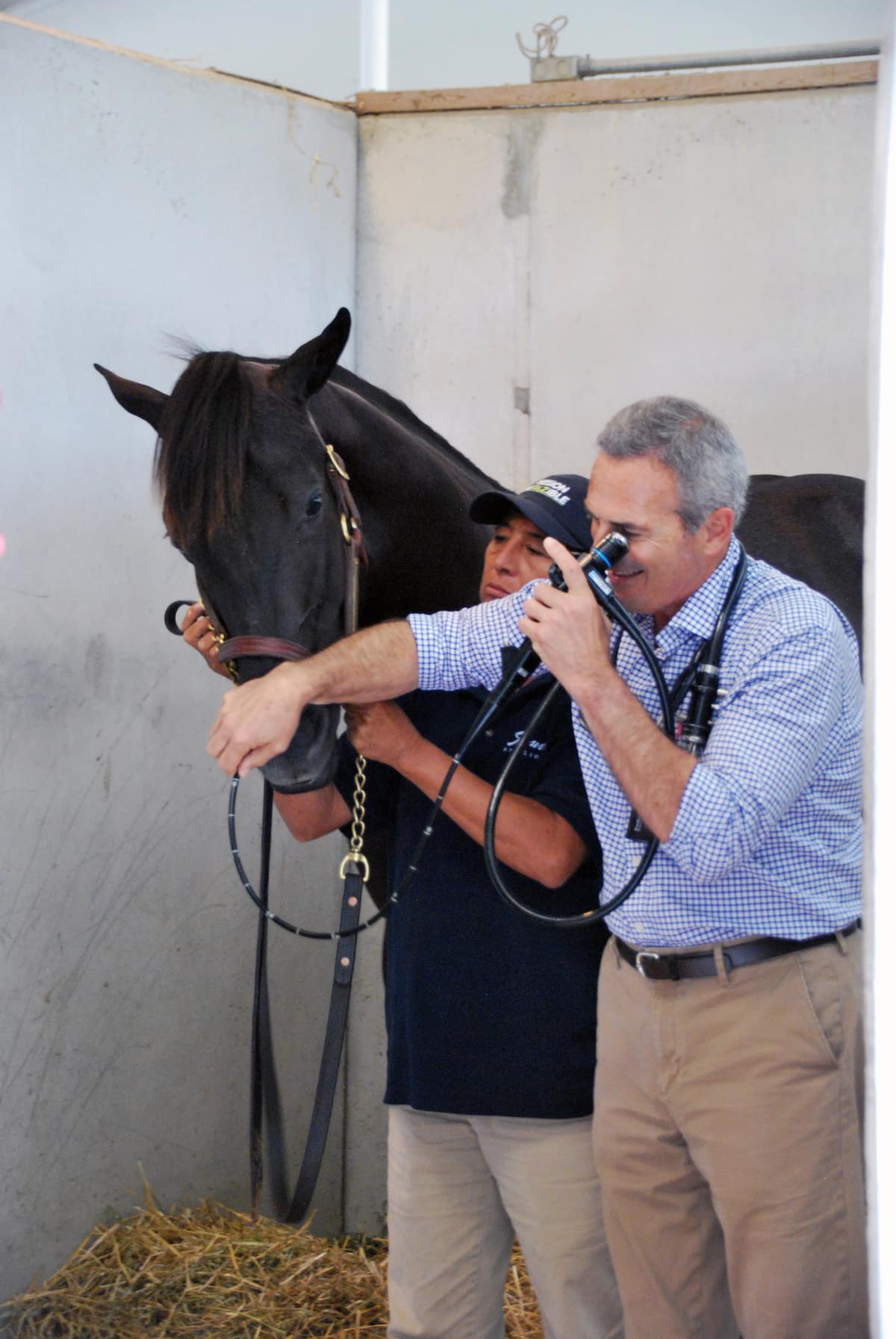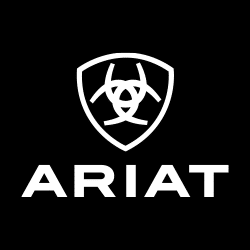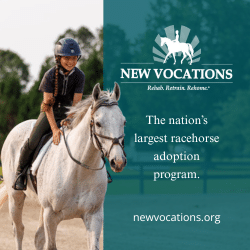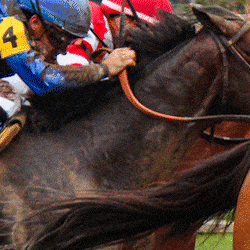Upper respiratory conditions don’t affect racehorses as often as other types of ailments, but can have significant impact when they do.

Veterinarians perform endoscopic exams to evaluate horses’ airways. Courtesy The Horse Staff
You can hear my 21-year-old off-track Thoroughbred (OTTB), Eldorado’s Tune, coming long before you see him crest a hill or turn a blind corner on cross-country. He’s a poster child “roarer,” meaning certain muscles in his throat are paralyzed, inhibiting air flow into the lungs and causing the loud breathing. But, in the seven years he’s been eventing, “Dorado” has never had any trouble handling the workload, and his veterinarian believes we wouldn’t see any ill effects unless he were to go preliminary level or higher (however unlikely at this stage in his life!).
Dorado tackles 1,500- to 2,000-meter courses, jumping roughly 15 to 20 jumps at about 400 meters per minute, and the only sign of his respiratory condition is that I have a rhythmical soundtrack for my ride. How is this possible?
I spoke with two authorities on equine respiratory issues to find out — Eric J. Parente, AB, DVM, Dipl. ACVS, professor of surgery at the University of Pennsylvania School of Veterinary Medicine’s New Bolton Center, in Kennett Square, and N. Edward Robinson, BVetMed, PhD, Hon. Dipl. ACVIM, Matilda R. Wilson Professor Emeritus at the Michigan State University College of Veterinary Medicine, in East Lansing. They explained the nuances of these conditions, which are characteristic of many Thoroughbreds coming off the track.
Racehorse Respiratory Issues
Many issues that could affect racehorses’ breathing rarely do, and describing them all would fill a small textbook, says Robinson. As such, we’ll focus on the most common airway problems veterinarians see in Thoroughbred racehorses.
Parente says upper respiratory conditions — those that impact structures ahead of the lungs, including the nasopharynx, soft palate, epiglottis and larynx — don’t affect racehorses as often as other types of ailments, but can have a significant impact when they do.
Robinson estimates that about 10% of racehorses have obstructions of the throat, like Dorado’s, that can limit their racing performance, such as roaring and dorsal displacement of the soft palate (DDSP).
A similar percentage of racehorses, he adds, suffer from lower respiratory tract conditions — those impacting the bronchi, the tubes that lead to the lungs, and the lungs themselves.
“Depending on the housing of the horses, (they) can have inflammatory airway disease (IAD), which is a noninfectious form of bronchitis caused by a dusty environment,” Robinson says.
He explains that a greater proportion of racehorses experience exercise-induced pulmonary hemorrhage (EIPH), but the severity ranges from mild to severe. It might never even be an issue in some horses.
Let’s look at what’s going on in a horse’s airway when he suffers from one of these conditions.
Roaring One of the most common upper respiratory conditions veterinarians see in racehorses, roaring results from an underlying nerve problem, Parente says, “particularly a muscle on the left side of the throat whose main function is to keep the flap (arytenoid) of the throat open.
“If you put a large stress (such as the strong negative pressures during inspiration when racing) on a weak muscle, it will have a tendency to fatigue and collapse,” he says. “Thus, the left side of the throat collapses.”
A horse doing significant exercise (such as racing or breezing) requires a lot of oxygen, but the collapsed muscle reduces air intake. This results in the characteristic “roaring” sound when the horse inhales, causing him to slow down.
“Most often it is treated surgically to hold the flap open (a procedure called a laryngoplasty, or tieback surgery) by using suture to take the place of the contracted muscle,” Parente says. “It can be very effective, but there are times when the opening as created at the time of surgery is decreased or the opening can cause problems for the horse protecting his windpipe from food or water contamination when they swallow.”
EIPH The lungs of horses with this condition bleed during intense exercise such as racing. Robinson says EIPH is a consequence of the normal physiology of racehorses, which have been selectively bred to run at high speeds and, so, consume a substantial amount of oxygen.
“Delivery of oxygen to the muscles requires very high blood flow through the lungs, and that is associated with very high pressures in the blood vessels,” he says, adding that increased pressure causes the blood to leak. “Most horses with EIPH lose only a small amount of blood, and the bleeding episode can only be detected by endoscopic examination of the windpipe (trachea).”
Only a few horses — 2% or less, Robinson estimates — develop severe EIPH, which might be visible as blood coming out of the nose (called epistaxis).
While EIPH is neither infectious nor painful, and there’s no evidence that it predisposes horses to developing other infections, it can negatively impact performance in some. Robinson says some severely affected horses can develop scarring in the lungs, especially in the dorsal and caudal regions (the upper rear parts of the lungs, almost under where the saddle sits). “This scarring may reduce the horse’s performance as an athlete but should not affect his usefulness as a pleasure animal,” he says.
Robinson says veterinarians use a diuretic medication called furosemide (marketed as Salix and sometimes called Lasix) to reduce EIPH severity during races. In theory, the drug draws water away from the lungs and keeps the blood pressure from getting too high, thus preventing it from leaking from the vessels into the lungs.
Furosemide is generally administered about four hours before post time, and it is the only medication racehorses in the United States are permitted to receive on race days.
DDSP This condition occurs when the horse’s palate becomes displaced on top of the epiglottis and partially obstructs the airway. It can develop when a horse breathes through its mouth and nose at the same time, Parente says.
“Horses’ anatomy of the nose and mouth is very different from ours, and they should always breathe through their nose; we, on the other hand, need to breathe through our mouth as we increase our effort,” he says.
Trainers can use different equipment, such as tongue ties or a figure-eight bridle, to try to prevent DDSP. Veterinarians can also employ surgical options, such as Llewellyn surgery (when surgeons transect the sternohyoideus, sternothyroideus and possibly omohyoideus muscles in the neck, sometimes also removing a small amount of the back edge of the soft palate) and tie-forward procedures, if a tack change doesn’t help.
“There is improvement in many horses with these treatments, but not all horses displace for the same reason and, therefore, not all treatments work on all horses,” Parente notes.
Epiglottic entrapment The epiglottis is a movable, leaf-shaped piece of cartilage located at the base of the tongue and above the soft palate. It covers the opening of the larynx to ensure that food and water do not enter the trachea but, instead, pass into the esophagus. In some horses, “the epiglottis has an extra membrane that wraps from underneath the epiglottis to over the top,” Parente says.
Should the epiglottis become trapped in that membrane, it can cause respiratory noise while exercising and/or poor performance. Or, it can cause DDSP.
“Typically this can be resolved by cutting the membrane (allowing it to “release” from over the epiglottis) with a laser or another surgical instrument to resolve the entrapment and allow it to heal back in its normal position,” he says.
Pneumonia and pleuritis Robinson says racehorses can also develop pneumonia (inflammation of the lungs caused by bacterial or viral infection) and/or pleuritis (inflammation of the pleura — the space between the body wall and the lungs — which frequently develops secondary to or in conjunction with pneumonia). Horses with pleuritis often accumulate fluid in their chest cavities.
“These conditions are generally a consequence of transportation of the horse over long distances without adequate access to water and opportunity to get its head down in order to drain the normal mucus out of the lungs,” he says. “The prevalence of these conditions has become less as horse transporters have recognized the need for horses to get their heads down.”
Robinson says horses with pneumonia and pleuritis “can be very ill, but if adequately treated can return to a normal life” with few to no negative effects on a successful second career.
Veterinarians treat pneumonia with antibiotics (which can be administered orally, intramuscularly, intravenously or with a nebulizer, depending on disease severity) and supportive care coupled with rest, generally several weeks to ensure a full recovery. Pleuritis is treated similarly, but veterinarians often must drain fluid from horses’ chest cavities to help the healing process.
Are Respiratory Problems Red Flags?
Not all OTTBs come with a complete medical history. In these cases, it can be difficult to determine (short of hearing a respiratory noise during exercise) whether a horse does, in fact, have a respiratory problem.
Robinson says veterinarians can perform endoscopic examinations to check for evidence of past surgical treatments or to evaluate the airway at rest or during exercise. He says veterinarians can sometimes feel scars around the larynx on palpation suggestive of past surgical airway procedures.
Parente adds that “if the surgical procedure was done successfully, the horse should not be noisy, should not have a problem eating or drinking and should be able to be competitive at other occupations.
“If the surgery was unsuccessful, or often the problem is not even addressed because of financial considerations or a presumed poor prognosis, then the horse will likely make abnormal noise during intense exercise or have evidence of trouble eating or drinking (coughing, feed material coming from the nose),” Parente says.
But should you be concerned if a horse you’re interested in has a history of respiratory problems?
“Respiratory issues would not be high on my list as red flags for potential buyers unless the horse was being considered for high-level, high-intensity competition,” Robinson says.
If an affected horse isn’t performing well enough as a racehorse, but doesn’t have complications, he could still be suitable for a less strenuous career.
Robinson offers a few points to consider about respiratory conditions and second careers:
■ “A horse that bleeds on the track is likely to bleed during events of similar intensity, such as upper-level cross-country work,” he says. Disciplines such as dressage, hunters, trail and even lower-level three-day eventing do not require the same degree of oxygen consumption as racing or upper-level eventing. He stresses, however, that it’s important to remember “that the majority of racehorses have very low-intensity EIPH. It is only those that had severe EIPH that should not perform the high-intensity events.” The bottom line: Most OTTBs won’t have bleeding issues during their second careers.
■ Robinson recommends avoiding disciplines that require a flexed neck — such as dressage and certain carriage-driving events — with horses affected by pharyngeal obstruction and/or DDSP. This headset can exacerbate such conditions and potentially inhibit performance.
■ Be wary of horses with a chronic cough or those that always cough at the start of exercise. “These horses are likely to have chronic airway inflammation, which could become more severe, resulting in the asthmalike condition known as heaves (also known as recurrent airway obstruction or equine asthma),” Robinson says. “It may be possible to keep the latter type horse in a low-dust environment (preferably pasture), but long-term management of heaves can be expensive,” and such horses often have limited performance capacities.
Words of Wisdom
In many cases, respiratory issues have little impact on OTTBs’ second careers. But that doesn’t mean you should ignore them completely. Don’t worry too much, Robinson says, but do your due diligence. Both he and Parente recommend having an experienced veterinarian perform a thorough exam on a prospect.
“Make sure that the horse undergoes an endoscopic examination of its nose and throat before being purchased, and if there is any doubt, the endoscopic examination should be repeated during exercise (dynamic endoscopy),” he says.
And once you’ve purchased your horse, Parente says to be vigilant for signs that a respiratory problem could be negatively impacting him, including abnormal noise during exercise, coughing and exercise intolerance.
“If there is any suspicion that something doesn’t seem right, have it checked out,” he says.










